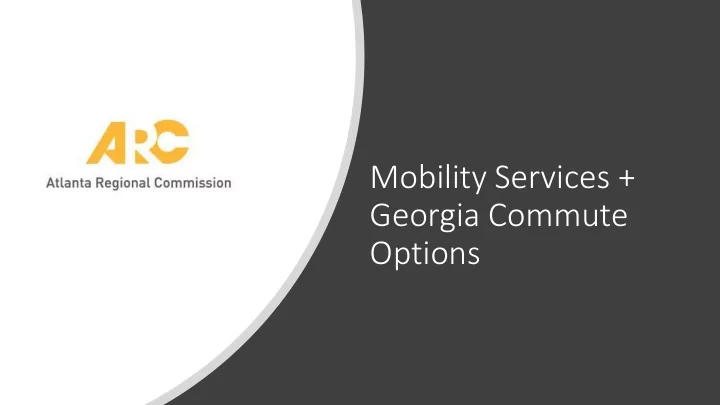

Mobility Services + Georgia Commute Options
What is TDM? Transportation Demand Management (TDM) means the use of strategies to inform and encourage travelers to maximize the efficiency of a transportation system leading to improved mobility, reduced congestion, and lower vehicle emissions.
Benefits of TDM Real Options for Commuters Transportation Demand Management programs and policies aim to provide commuters with a mix of reliable and affordable transportation options. Supported with effective marketing and advanced technologies, commuters can make informed choices to meet each trips unique needs, while considering cost, time, and convenience. Reduced Traffic Congestion With even a small reduction in the number of single occupancy vehicles on our nation’s roads, commuters can see significant reductions in congestion. TDM supports the most efficient use of our existing infrastruc-ture by increasing per person throughput and allowing more people to use our infrastructure.
Benefits of TDM Improved Public Health and Safety With reduced reliance on personal vehicles, our communities will see cleaner air leading to direct improve-ments in public health. TDM initiatives that support increased levels of walking and cycling also enhance overall quality of life; and more people on our streets and sidewalks will create safer neighborhoods. Connecting People to Jobs & Supporting Economic Activity With more commuting options and less traffic, people will have better and more reliable access to jobs. Busi-nesses will see increased productivity from employees who spend less time stuck in traffic; and products will move quicker to market.
Leading Metro Atlanta Into The Future
The Atlanta Region’s Plan “governs and contributes to the work we do”
The Atlanta Region’s Plan and GCO
Regional TDM Program Framework
TDM Program Funding Flow Federal Highway Administration Georgia Department of Transportation Atlanta Regional Commission Transportation Management Georgia Commute Options Associations
ARC Regional TDM Program
Commute Flows East Metro I-75 North I-85 North North Fulton Southern Origin Airport Buckhead Cumberland Decatur Downtown Corridor Corridor Corridor Midtown / 400 Corridor Perimeter Crescent 18% 3% 4% 2% 10% 4% 2% 5% 5% 2% 4% 42% Clayton 3% 7% 24% 3% 12% 4% 18% 3% 11% 4% 10% 0% Cobb 4% 7% 4% 14% 10% 22% 0% 7% 10% 6% 12% 3% DeKalb 8% 11% 6% 6% 13% 5% 2% 4% 19% 14% 10% 3% Fulton 1% 5% 2% 5% 5% 10% 0% 49% 6% 8% 8% 1% Gwinnett 0% 3% 3% 3% 6% 4% 2% 27% 2% 39% 10% 0% NE 3% 5% 12% 1% 6% 1% 40% 2% 4% 18% 8% 0% NW 11% 2% 2% 5% 11% 19% 1% 11% 6% 2% 2% 29% SE 14% 4% 10% 3% 8% 2% 4% 2% 10% 1% 5% 36% SW
Primary Alternative Modes 57% 52% 46% 40% 2019 (n=1,768) 2014 (n=1,007) 2010 (n=680) 2007 (n=531) 30% 25% 23% 15% 13% 13% 13% 12% 12% 11% 11% 9% 6% 5% 4% 2% Telework Carpool/Vanpool Train Bus Bike/Walk
Duration of Alternative Mode Use (Primary Mode) 40% 32% 8% 20% 37% 26% 11% 26% 24% 27% 17% 32% 16% 32% 43% 9% Bus n = 256 Train n = 285 Carpool n = 179 1-12 months 13-36 months 37-60 months More than 60 months Bike/walk n = 150 Q30 How long have you been using <type of transportation> to get to work?
Recommend
More recommend